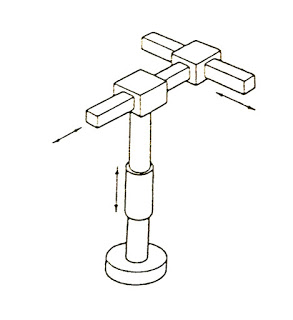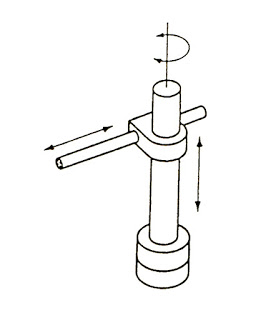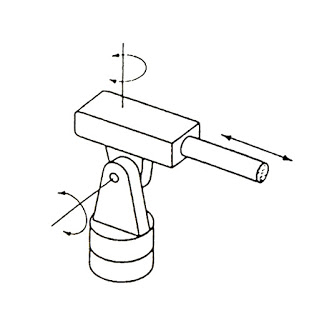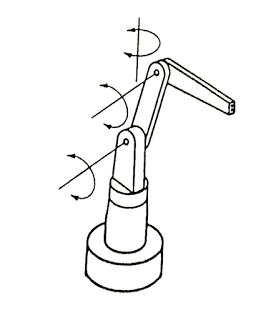Category:Robotic
Here you can find a very brief overview of robots used in manufacturing. It talks about what is it that makes a machine a robot, what differentiates the various types of robots, different ways robots can move, and three types of power sources for robots.
Contents
The term Robot
Karl Capek coined the term robot in 1920. He was a Czech playwright who wrote R.U.R. which stands for Rosumovi Univerzální Roboti (Rossum’s Universal Robots).
Robots
What differentiates a robot from says a crane? How is it different than a 3D printer or a CNC router? There are three key capabilities which make a robot a robot: A robot needs at least 4 degrees of freedom. A robot needs to be Reprogrammable. A robot needs to be Multi-functional.
Basic terminologies
Work Cell: All the equipment needed to perform the robotic process (robot, table, fixtures, etc.)
Work Envelope: All the space the robot can reach.
Degrees of Freedom: The number of movable motions in the robot. To be considered a robot there needs to be a minimum of 4 degrees of freedom. The Kuka Agilus robots have 6 degrees of freedom.
Payload: The amount of weight a robot can handle at full arm extension and moving at full speed.
End Effector: The tool that does the work of the robot. Examples: Welding gun, paint gun, gripper, etc.
Manipulator: The robot arm (everything except the End of Arm Tooling).
TCP: Tool Center Point. This is the point (coordinate) that we program in relation to.
Positioning Axes: The first three axes of the robot (1, 2, 3). Base / Shoulder / Elbow = Positioning Axes. These are the axes near the base of the robot.
Orientation Axes: The other joints (4, 5, 6). These joints are always rotary. Pitch / Roll / Yaw = Orientation Axes. These are the axes closer to the tool.
Classification
Industrial robots can be classified into six categories based on the following characteristics: Degrees of Freedom Arm Geometry Power Source Types of Motion Path Control Intelligence
Degrees of Freedom
The number of movable motions in a robot defines its degrees of freedom. In articulated robots such as those in the Fab Lab have at least 6 degrees of freedom. These joints, or axes, are broken into two categories. The three joints nearest the base of the manipulator are called the positioning axes. The three closest to the tool are called the orientation axes. Robots can have larger degrees of freedom by having external axes, for instance, the entire robot can be mounted on a sledge which moves along a track. This would be the seventh degree of freedom.
Motion
Singularity
Arm geometry
The arm geometry, that is the configuration and type of joints used, determines the shape of the work envelope.
Rectangular (Cartesian)
The work envelope is a box. All three axes are linear.

Cylindrical
The work envelope is a cylinder. Axis 1 is rotary. Other axes are linear.

SCARA This is a variation of a cylindrical work envelope robot. SCARA is an acronym for Selective Compliance Articulated Robot Arm. Joints 1 and 2 of this type are rotary and in the same plane. Joint 3 is linear. These are often called Pick and Place robots. File:Scara.jpg
Spherical
This type of arm geometry produces a ball-shaped work envelope.
Axes 1 and 2 are rotary. Axis 3 is linear.

Articulated
This type of arm geometry, which is what we use in the Fab Lab is also referred to as Jointed Spherical.

Power source
The three most common method of powering robots are air pressure (pneumatic), fluid pressure (hydraulics) and electricity. The main characteristics of each of these methods are listed below:
Pneumatic Weakest Fastest Clean Inexpensive Low Tech Open loop (non-servo) Stop-to-stop for path control Uses hard-stops determine program locations Loud - referred to as "bang bang" robots
Hydraulic Most powerful (greatest payload) Messy to repair Closed loop (servo) More flexible than pneumatic Mid-range in noise Oil used can contaminate paints Most expensive (have to buy both hydrallic and electronic systems) Most costly to repair (have to fix both hydraulic and electronic systems)
Electric Most popular Clean Quiet Closed loop (servo motors) Most flexible Can use sealed motors for painting
All this information is coming from from http://mkmra2.blogspot.com/search?q=robots
This category currently contains no pages or media.